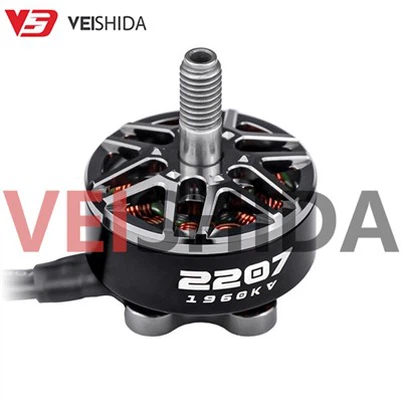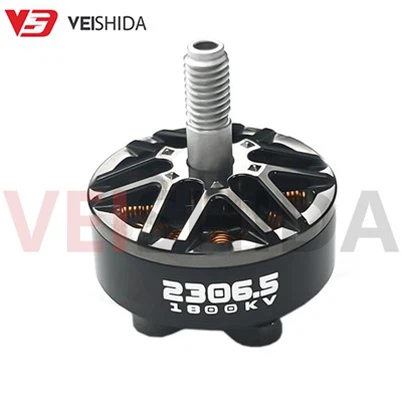Why Are FPV Drones So Fast? It Comes Down to Power and Aerodynamics
Leave a message
FPV (First Person View) drones are known for being "fast, accurate, and agile". Their flight speeds often far exceed those of regular consumer drones, sometimes reaching an astonishing 200 kilometers per hour. For users who are new to this field, the high-speed performance of FPV may seem "supernatural", but in fact, it stems from the synergy between two core factors: a powerful propulsion system and efficient aerodynamic design.
On the one hand, the motor, as the heart of the power system determines the drone's thrust-to-weight ratio, responsiveness, and overall flight dynamics; on the other hand, the aerodynamic structure optimizes the wind resistance and streamline shape during flight, allowing the motor's power to be maximized.
In this article, we'll break down the technical principles behind how FPV drones achieve extreme speed, from the KV value and thrust output of the motor to the lightweight and aerodynamic design of the frame and blades. At the same time, we will also help you understand how to make appropriate motor configuration choices between speed and controllability.

High-KV motor brings extreme speed performance
One of the key factors for the amazing speed of FPV drones is the high KV brushless motor, but it is not the only reason. The KV rating (RPM/V) indicates the motor's no-load speed per volt of input. The higher the KV value, the faster the motor speed at the same voltage, which drives the propeller to generate greater thrust and propels the drone to achieve high-speed flight.
The role of high KV motors
Speed advantage: For example, a 2000KV motor can reach 24,000 RPM at 12V, while a 1000KV motor can only reach 12,000 RPM. High speed means more agile response and greater thrust-to-weight ratio, helping FPV drones complete acceleration and maneuvers in a short time.
Power characteristics: Although high-KV motors have relatively low torque, it can withstand higher current and is suitable for scenarios that require high-speed response and flexible maneuverability, such as racing flights and complex movements.
Other factors that affect the speed of FPV drones
Propeller: Small-diameter, high-pitch propeller blades efficiently convert motor RPM into thrust when driven by high KV motors. For example, 5-inch aircraft are often equipped with 21×47 propellers, which can deliver high thrust in a short burst.
Battery: Lithium batteries with high discharge rates (such as 75C, 100C or 120C) can provide stable high current to the motor, ensuring that it continuously outputs power at high speeds and maintains high-speed flight.
Flight control system: The flight controller responds rapidly to pilot input and accurately controls the motor speed and direction, making the drone stable and flexible during high-speed flight.
Frame design: Lightweight and streamlined frame reduces overall weight and air resistance, improving acceleration and top speed performance. Carbon fiber material has become the mainstream choice for racing machines due to its light weight and high strength.

How aerodynamic design affects speed
The extreme speed of FPV drones not only depends on a powerful power system, but also on aerodynamic design. Optimizing aerodynamic design can reduce air resistance and convert motor output into speed more efficiently.
Body design
Streamlined body: The streamlined appearance can significantly reduce air resistance. Take the DJI FPV as an example, its tall and narrow profile minimizes drag and air resistance at high speeds, allowing the drone to easily break through air obstacles.
Smooth surface treatment: Smooth fuselage reduces drag and minimizes turbulence, reducing energy loss. Materials such as carbon fiber are widely used due to their smooth finish and light weight, making high-speed flight more efficient.
Wing and aspect ratio design
Airfoil selection: a thin airfoil can generate sufficient lift while maintaining low drag at high speeds, and is a common choice for racing FPV drones.
Optimization of aspect ratio: High aspect ratio wings reduce induced drag, improve speed and efficiency, but a balance needs to be struck between lift, drag and structural strength.
Propeller design
Blade shape and number: Blades with thin edges and thick roots are more efficient when rotating at high speeds; two-blade propellers are efficient and fast, while three-blade propellers have great thrust and are suitable for aggressive flight.
Pitch and diameter: A larger pitch can increase speed, but it will also increase resistance; the propeller diameter needs to be selected reasonably based on the UAV's power system and speed target.
Overall layout optimization
Position of the power system: Reasonable layout of the motor and propellers reduces air disturbance. For example, the rear propeller design can effectively reduce the resistance caused by the front shear flow.
Aerodynamic arrangement of components: Cameras, batteries, and image transmission equipment should be installed in concealed or streamlined locations to minimize interference with airflow and ensure smoothness during high-speed flight.
Summary: Excellent aerodynamic design can allow FPV drones to utilize the power system output more efficiently and achieve faster and more stable flight.

The relationship between lightness and speed
Lightweight is one of the important factors for FPV drones to achieve high-speed flight. It not only reduces energy consumption, but also improves overall flight performance, including propulsion, aerodynamics, and payload efficiency.
Powertrain: Reduce weight and improve efficiency
Lower energy consumption: After the weight of the fuselage is reduced, the thrust required by the motor is reduced, and the same battery capacity can support longer high-speed flight. For example, the micro FPV drone "Prowess" made by Xu Yang, a student at the Chinese University of Hong Kong (Shenzhen), weighs only 247 grams and achieves a flight speed of 340 kilometers per hour through lightweight design.
Optimize motor selection: A lighter body allows the use of smaller and more efficient motors, allowing the propellers to spin faster at the same power while improving heat dissipation, thereby maintaining stable power output during continuous high-speed flight.
Aerodynamics: Reduce drag and increase speed
Reduce air resistance: Lightweighting is usually accompanied by optimization of the fuselage structure, making the drone more streamlined, which can effectively reduce air resistance during high-speed flight. For example, many high-performance racing aircraft made of carbon fiber can fly faster at the same power by optimizing the fuselage curve.
Enhanced maneuverability: Reduced weight means less inertia, allowing the drone to more quickly complete sharp turns, dives and other maneuvers. This is especially important in racing competitions, where a lightweight body can help pilots pass through narrow tracks and complex obstacles faster, increasing overall flight speed.
Payload management: balancing speed with mission requirements
Increase payload space: Lightweighting frees up weight for other mission equipment. For example, an aerial photography FPV drone can still maintain high-speed and stable flight while carrying a high-definition camera and image transmission system.
Reduce the impact of load on speed: Too heavy a load will significantly increase power consumption and slow down the speed. Through lightweight design, FPV drones can maintain excellent speed and maneuverability while carrying necessary equipment even when performing reconnaissance or heavy-load missions.
Summary: Lightweighting is not just about reducing weight. It is about maximizing power efficiency, reducing air resistance and optimizing load performance while ensuring structural strength, so that FPV drones can fly faster and more steadily.

How to find a balance between speed and control
To find the ideal balance between speed and control for FPV drones, you need to start from hardware selection, parameter settings, flight skills, etc. Here are the specific methods:
Hardware Selection
Motor and propeller
High KV motors rotate faster, bringing higher speeds, but the control stability may be reduced; low KV motors rotate slower, and the control is more stable, but the speed is limited. In terms of propellers, narrow blades, thicker roots, and large pitch propellers are suitable for racing, while wider and thinner blades are better suited for stable flight. Selecting propellers with good comprehensive performance helps to balance speed and control.
Battery
Battery capacity and discharge rate directly affect power output and endurance. Large-capacity, high-discharge rate batteries can support stronger power and faster speeds, but increased weight may reduce control flexibility. Reasonable selection should be made in combination with the overall design of the drone to balance speed and control.
Flight Control
Flight control performance and parameter settings have a huge impact on the control experience. Choose a flight control with high sampling rate, fast response and advanced control algorithm to improve control accuracy and stability. Adjust flight control parameters based on drone hardware and flight needs.
Parameter settings
PID parameters
The P, I, and D values in PID affect the response speed and stability of the drone. The higher the P value, the more sensitive the response, but it is prone to oscillation; the I value eliminates steady-state errors and maintains stability; the D value suppresses oscillation. Adjust the PID parameters through repeated test flights to find the best balance between speed and control.
RC Rate and Super Rate
RC Rate determines the joystick response speed. The larger the value, the faster the response but the more difficult the control. Super Rate increases the roll and pitch speeds, improves maneuverability, but may affect stability. Set these two parameters reasonably based on flight experience and needs.
Flying skills
Getting familiar with flight mode
The self-stabilizing mode is suitable for beginners and provides good stability; the manual mode is suitable for advanced pilots and allows for faster and more flexible movements. Switch flight modes according to the scene and needs to gradually improve your control level.
Reasonable control of throttle and joystick
The throttle controls the altitude, and the joystick controls the attitude. When flying at high speed, reduce the joystick amplitude to maintain stability, and operate the joystick quickly and accurately when turning or moving to avoid excessive control.
Develop spatial perception
Through simulator training and actual flight, the ability to judge the position and posture of the drone can be improved, and the control accuracy and reaction speed can be improved.
In this way, hardware configuration and parameter debugging complement each other, and coupled with the pilot's control skills, the FPV drone can maintain accuracy and stability during high-speed flight.

Choose high-performance motors to drive FPV flight to the limit
The speed and control performance of FPV drones cannot be separated from the support of high-quality power systems, and the motor is the core driving force. Parameters such as KV value, power, torque, and heat resistance directly affect flight speed and stability. Only by choosing a motor with excellent performance and precise matching can your FPV drone stand out in fierce racing and complex maneuvers.
As a professional FPV drone motor manufacturer, VSD has rich R&D experience and advanced production technology, and is committed to providing efficient, reliable and customized brushless motor solutions to global customers. The following are several popular VSD drone motor models:
|
Motor Model |
KV value range |
Applicable voltage range |
Maximum power(W) |
Maximum thrust(g) |
|
380KV |
6S~12S |
4257 |
9034 |
|
|
420KV |
6S~8S |
3037 |
7232 |
|
|
900KV~1520KV |
5S~8S |
1617 |
4185 |
|
|
1800KV~2400KV |
4S~6S |
901 |
1683 |
|
|
1300KV~1950KV |
6S |
1623.5 |
2910.4 |
These motors cover different KV values and power requirements, meeting a variety of flight scenarios from racing, freestyle to aerial photography and heavy loads. VSD motors are not only leading in performance parameters, but also pass strict quality inspections and high-standard manufacturing processes to ensure that each motor can withstand high-intensity flight tests.
Choosing VSD means choosing professional-grade quality and technical assurance. Through strict quality control and diversified testing, we ensure that each motor can operate stably in a high-intensity flight environment, helping pilots break through speed limits and enjoy the ultimate flight experience.
Want to make your FPV drone faster, more efficient, and more responsive? Welcome to contact us to learn more about VSD high-performance motor products and customized services to accelerate your flying dream!








